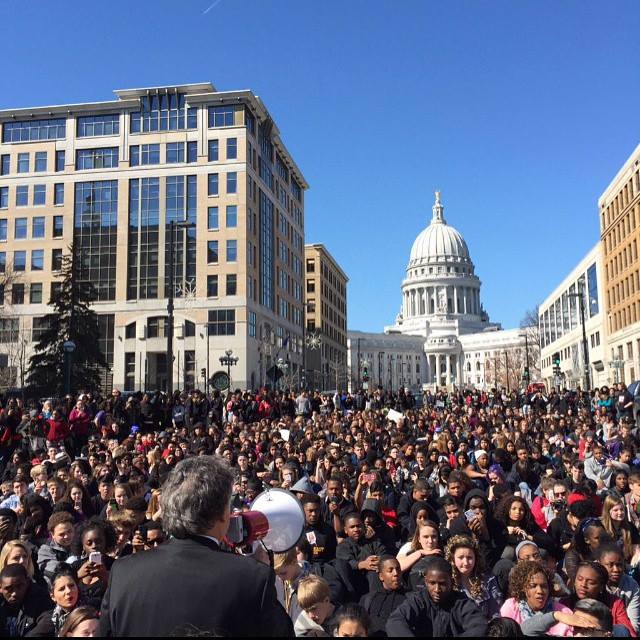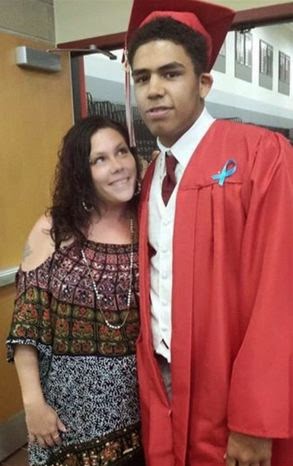Madison, WI, progressive bastion of the Midwest (or so its residents like to think) saw itself become the next city to kill a black, unarmed teenager post-Ferguson last Friday night (March 6). The teen, Tony Robinson, was shot five times by a police officer in a house on “Willy Street” on Madison’s East Side. In the days following, protests have grown in size, and with them, media coverage has grown in frequency and scope.
As a white Madison resident concerned with the city’s disproportionate arrest of black men (they’re 8 times more likely to be arrested than white men here), and the spatial and economic segregation of the community, I have so many thoughts and so very many feelings.
As a scholar, I am overwhelmed by all there is to see and hear. Speeches. Gestures. Blog posts. Newspaper articles. Videos. Still images. Some coalitional. Some divisive. Some purporting to be descriptive. Some honest about offering interpretation. All rhetorical.
While I continue to process what I might have to say about these events, today my aim is curatorial. Here, I share with you some select moments from the last few days which bolster my belief that rhetoric is no ancient art, but very much alive and well in these United States:
- Actively working to combat the common representation of fallen black men as “thugs,” Tony’s mother requested that this photo of him at his high school graduation be the one circulated in the media:
- Media representations of Tony have tended to align with common tropes used to explain why black men are killed by police. Despite his family and friends’ efforts to talk about him as fun-loving, helpful, smart, and kind, this one clip from CNN, for example, represents Tony as mentally troubled, a criminal, and a troubled teen who had fallen in with the “wrong crowd.”
- Madison’s police chief demonstrated the Platonic tradition of denigrating rhetoric even as he employed it to apologize to the community. In a March 9 “Message to the Community” blog post, Chief Koval points to Sir Robert Peel, the “founder of modern policing,” to explain that “POLICE ARE THE PUBLIC AND THE PUBLIC ARE THE POLICE” (Koval’s emphasis). He then employs a number of metaphors: putting on “armor” each day, thinking about the police as “guardians” of “the vulnerable, the voiceless, the victims.” Then, as he concludes, he writes, “Let us continue to demonstrate to you that our commitment transcends mere rhetoric” (emphasis mine).
- A Milwaukee science fiction and fantasy author took on the role of argumentation scholar that same day, analyzing common arguments made in the wake of events like Robinson’s killing. His piece, “4 Reasons Not to Get Upset About Tony Robinson and Why They’re All Bullshit” responded to 1) calls to “wait for the facts,” 2) arguments that “officers have to protect themselves,” 3) questions about why protestors aren’t “protesting criminals” instead of police, and 4) colorblind assertions that “people shouldn’t make it all about race.”

Image source: The Isthmus, a Madison, WI newspaper.
- Scholars of traditional public address often hear that their work matters little in a digital world, but the above image of Madison Mayor Paul Soglin addressing more than 1,500 young protestors on Martin Luther King Jr. Boulevard suggests otherwise. As the street name reminds us of one of the great orators of last century’s civil rights movements, Soglin’s bullhorn before this group of protestors demonstrates the continued expectation that political leaders speak in times of social and/or political upheaval.
- “Indict. Convict. Send those killer cops to jail. The whole damn system is guilty as hell.” “Hands Up, Don’t Shoot!” – As the crowd marched across the city, these collective chants demonstrated a belief that shared words and shared experience (the aural, the embodied, and the visual) were important to communicate their response to the deaths of unarmed black youth and adults in Madison, and beyond.
Of all the chants that I’ve heard at this week’s protests, my favorite one is this: “This is what democracy looks like! This is what democracy looks like!” From a community grappling with principles of fairness, equality, and justice this week, I offer these examples to illustrate the critical role rhetoric plays in these negotiations. As rhetorical scholars, we are trained to notice, think through, and make sense of these symbolic representations. However, as I hope the above illustrates, and as this blog hopes to communicate, everyone is always both a rhetor and a rhetorician.




Whitney, thanks for this post. “To curate” comes from the Latin word meaning care; putting these moments together without giving us a hard and fast argument about what they mean demonstrates that care.
Thanks, KC!